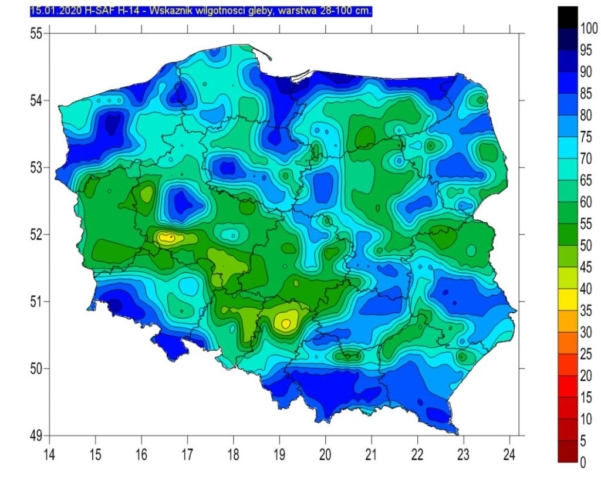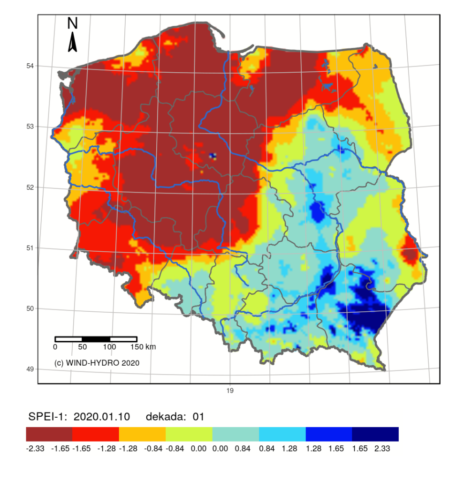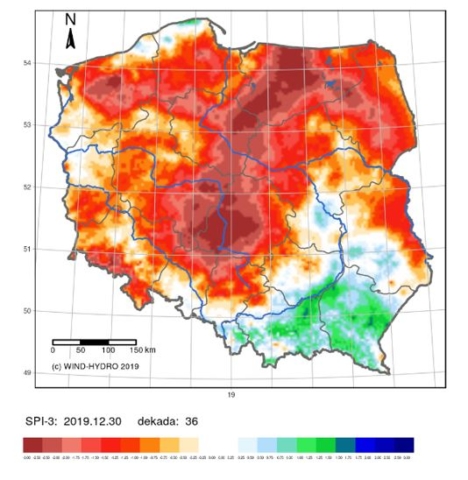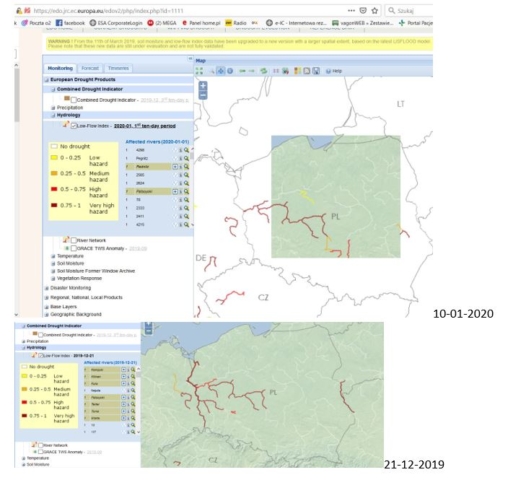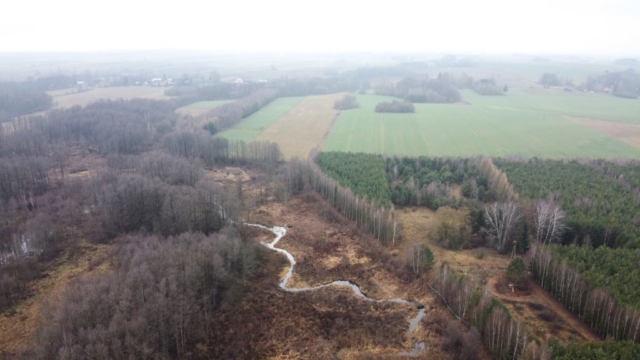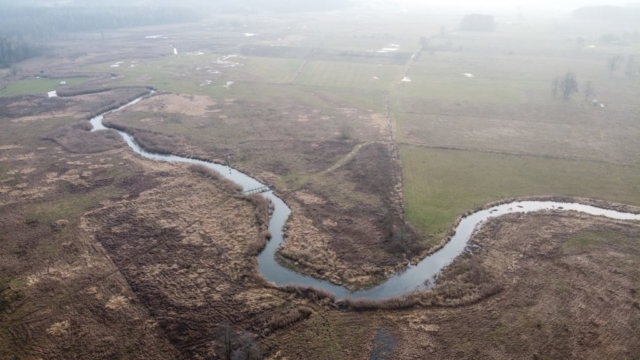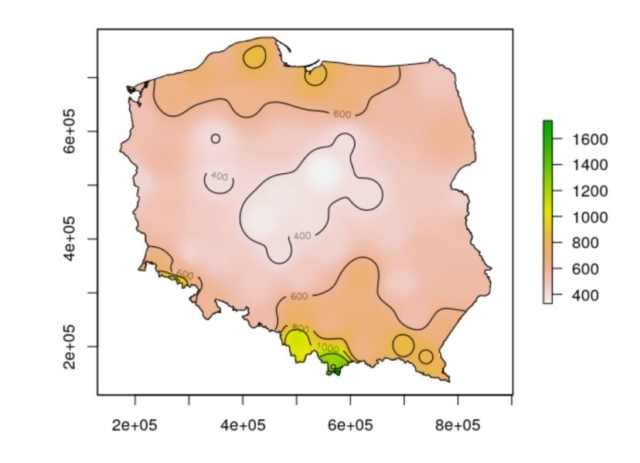Drought is a very complex phenomenon and the fight against its effects cannot be based on a single solution. We need to act on many fronts.
At Wody Polskie we have been immensely busy working on the analysis of extreme hydrological phenomena. We also design and build modern hydrotechnical facilities and introduce innovative programmes to improve the condition of water resources in Poland.
In this article we present the latest information on drought risk, determined by measurement and satellite data. This has been prepared for the first drought effects counteracting plan in Poland, which we are currently developing. As part of the project, we are creating a catalogue of actions to reduce the amount of losses caused by drought and to ensure effective monitoring of water resources and water management. We also provide information about our current activities aimed at improving water quality and counteracting the increasing frequency of extreme phenomena such as drought. More information about the drought effects counteracting plan can be found at: www.stopsuszy.pl
We need a proper diagnosis
For two years, since our farm was established, we have been studying the phenomenon of drought in Poland using modern technologies and European standards. An in-depth analysis allows us to prepare the right strategy to counteract the effects of water deficit in the environment. There are several types of drought. We can distinguish between meteorological drought, agricultural drought, hydrological drought (which concerns surface waters) and hydrogeological drought (which concerns groundwater). Last year, Poland was especially hard hit by agricultural drought. The latest data on the soil moisture index for January 2020 show low levels of soil moisture below 40%, and in some cases even below 35% (at depths below 1m). The main reason is the absence of precipitation – a snowless, dry and warm winter – which makes it impossible to restore soil moisture. Currently, in the area of Kujawy, Zachodniopomorskie Province through Pomorskie, Wielkopolskie and half of the Łódzkie and Warmińsko-Mazurskie Provinces, the data indicates a very intensive meteorological and agricultural drought.
Map presenting soil moisture at the depth of 28-100 cm, according to www.agrometeo.pogodynka.pl
Map of the S4D (Service 4 Drought) project implemented with the funds of the European Space Agency SPEI index. Condition for the first 10 days of January 2020
Map of the S4D (Service 4 Drought) project implemented with the funds of the European Space Agency SPEI index. Condition for the first 10 days of January 2020
The unfavourable conditions of the current dry winter are evidenced by the water balance values for the whole period from autumn and winter. The assessment is made possible by an index showing the conditions of atmospheric precipitation supply. This is from the standardized precipitation index calculated over a specific three-month period (SPI3), according to the S4D project data, which identifies areas where low or scarce precipitation does not ensure proper soil moisture or shallow groundwater supply. In the case of further scarce precipitation, plants will begin to grow in drought conditions during the coming spring.
Index (SPI3) showing the conditions of atmospheric precipitation supply, the so-called standardized precipitation index calculated over a specific 3-month period. Map of the S4D (Service 4 Drought) project implemented with the funds of the European Space Agency SPEI index. Condition for the first fortnight of January 2020
Note! Phenomena such as drought and flood are cyclical. Periods of heavy rainfall and periods of drought have been observed and recorded for hundreds of years. It is suspected that these phenomena are associated with solar activity that affects the formation of clouds in the atmosphere. On the other hand, drought intensity is the effect of precipitation deficits and water retention conditions, including land use, agricultural practices, the use of water resources, etc.
Key word: retention
To improve the condition of water resources in Poland, it is necessary to improve water retention. Therefore, at Wody Polskie, we have speeded up modernisation works on the existing reservoirs by increasing their retention capacity. An example of this is the revitalisation of the Rzeszów Reservoir, which is a source of drinking water for the city and a popular recreation destination in the region. We also plan to revitalise and restore the biological balance of the Zemborzycki Reservoir in Lublin. This year we are starting modernisation works on the Jeziorsko and Sulejowski Reservoirs, which were especially affected by last year’s drought.
We are planning new retention solutions and designing multifunctional reservoirs, which will not only constitute a water reserve during a time of drought, but will also protect us against flooding. Wherever possible, we plan to convert dry flood protection reservoirs into wet ones. Large retention reservoirs ensure the stability of groundwater levels in adjacent areas throughout the year. Surface water users also benefit from the creation of such reservoirs – they regulate the flow of rivers, thus delaying and reducing the intensity of hydrological drought.
At our farm we also work on increasing water retention of river basins as part of river restoration programmes. The aim is to restore the natural character and connectivity of the rivers and improve conditions for ecosystems. In February this year, we are going to complete the development of the national programme for surface water re-naturalisation which started in 2019. It will identify priority areas and assign measures which should be implemented as a priority due to environmental and economic conditions. This will be done in order to restore the natural condition of watercourses and water reservoirs that – to a greater or lesser degree – were transformed by man. The development of the renaturalisation programme will be considered during subsequent investments carried out by Wody Polskie. This year we are completing the work on another programme to restore the blue migration corridors on the Biała Tarnowska River – more information about this project can be found at: https://biala-tarnowska.org/ and in the publication: https://www.wody.gov.pl/aktualnosci/743-wody-polskie-przywracaja-biala-tarnowska-przyrodzie-i-ludziom
We also actively support retention programmes implemented by the State Forests, the Ministry of Maritime Economy and Inland Navigation and the Ministry of Agriculture and Rural Development. At present, water retention in Poland remains at the level of 6.5 percent of the average outflow. It should be at least twice as high, so that the accumulated resources are able to meet all the needs of people, economy and the environment. Therefore, measures implemented for retention should be carried out by various entities – not only state institutions, whose activities are related to water management, but also local governments, social organisations and citizens. How quickly does water ‘escape’ via rivers and flows into the Baltic Sea? We saw an example last year when as a result of intensive spring rainfall, the water level in some of the Polish rivers, including the Vistula River, suddenly rose. At the beginning of June, the depth of water at the Vistula Boulevard water gauge was almost 600 cm. Six weeks later, at the same water gauge, the depth of water reached only 40 cm! The only solution that can effectively prevent this phenomenon is retention. Large investments planned by ‘Wody Polskie’, such as Lubiąż and Ścinawa barrages on the Odra River or Siarzewo barrage on Vistula, are necessary to ensure that the major Polish rives do not disappear due to drought. At present, we can observe such phenomena in the form of low-water on the Warta River and its tributaries. A state of hydrological drought is also recorded on the Pilica, Wieprz and Lower Noteć Rivers.
Print screen from the European Drought Observatory – on the right-hand side one can see the dates showing the condition as of December 2019 and January 2020. Source: www.edo.jrc.ec.europa.eu
At the end of December 2019, water levels on the Odra, Nysa Łużycka and Bug rivers were very low. This information is also confirmed by IMGW’s hydrological monitoring. Hydrological drought is currently recorded through low water levels at water gauges in the drainage areas of the Nysa Kłodzka, Łużycka, Odra, Warta and Czarny Dunajec Rivers (data from: posucha.imgw.pl). Therefore, it is necessary to increase water retention to conserve water resources, important both for the region’s inhabitants and for river-dependent ecosystems, such as meadows and riparian forests or peat bogs.
Current photos showing drying swamps in Podlasie. The photographs come from posts published by Jarek Stepaniuk Podlasie on his Facebook profile.
Why do we observe drought in winter?
At this time of the year, at least half of Poland should be covered with snow. Winter precipitation provides a significant supply of water to the soil, streams and rivers. In Poland, there has been little snowfall both this year and last year, which means that drought can occur in spring.
For many years meteorologists have also been observing a change in the nature of precipitation. The number of frequently recurring heavy rainfall events in Poland has been increasing. It it generally observed during the spring-summer season. As a result, rainwater quickly runs down to the rivers and does not sufficiently penetrate the soil. Both of these phenomena, combined with high temperatures (which accelerate the evaporation of water from the soil, water reservoirs and vegetation), favour the phenomenon of drought.
So far, there has been very little snow this winter, which – as we explained above – results in a worse soil fertility. In 2019, the situation was similar. In winter there was little rainfall. During the year, heavy rains occurred periodically. However, the annual precipitation in 2019 did not deviate significantly from the long-period average (which is: 650 mm).
541.6 mm – this is the average precipitation in Poland for 2019.
(min.: 328 mm) (max.: 1730 mm)
Map showing the averaged annual precipitation in Poland in 2019 based on measurement data from IMGW’s synoptic stations. Source: S4D project (Service 4 Drought – WIND-HYDRO)
Everyone should contribute to counteracting the effects of drought
Large retention reservoirs, providing sufficient water for the regions, are major investments that will be built over the next few years. However, other solutions can be implemented much faster. Local measures can contribute to the creation of small reservoirs, ponds and waterholes – the so-called small retention and micro-retention. In the fight against drought it is also important to create green areas, plant trees and shrubs on wasteland, rural and urban areas. At Wody Polskie we also promote the sowing of plants in squares, urban parks and even home gardens. They do not require abundant watering (such as lawns), and they support soil retention. In addition, they are a habitat for insects, birds and other animals, whereby they increase biodiversity. Our farm also supports local rainwater retention programmes and solutions such as rainwater harvesting systems, absorbent boxes or rainwater-fed gardens. Changing habits, such as not using drinking water to water the garden or wash the car are some of the main tips we offered last year as part of the Stop Drought! campaign. Click on the link to watch the video: https://www.youtube.com/watch?v=8D5f12dfbZQ&t=9s
As part of the Stop Drought! Programme last year, we also conducted public consultations, during which we listened to the opinions of over 1000 representatives from various institutions and organisations dealing with water management, agriculture and forestry. During the meetings, more than 100 comments and insights were submitted to the consulted drought effects counteracting plan. Of greatest interest was the construction and reconstruction of retention tanks. The importance of education was also emphasised. We are waiting for your comments to the document
– the six-monthly public consultation ends on 15 February 2020. www.stopsuszy.pl). As part of the Stop Drought! programme we also held a competition for children and youth – ‘How do you save water?’. We promote sensitivity to the problem of small water resources in Poland. Education is an important element of our activities for 2020. More information is available on our website: www.stopsuszy.pl
The phenomenon of drought is multidimensional and dynamic. Due to the fact that weather conditions may change, we will keep you informed about the meteorological and hydrological situation on our website.
Social Communication Team PGW WP
The text was prepared in cooperation with Małgorzata Stolarska, PhD, head of the scientific team developing the first drought effects counteracting plan in Poland


